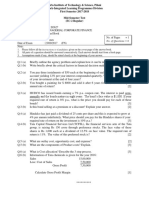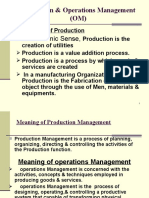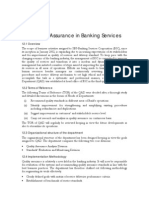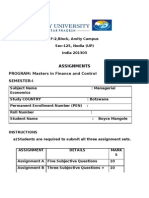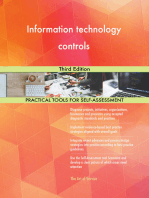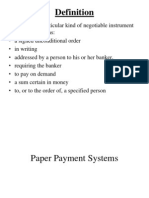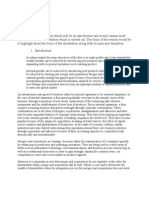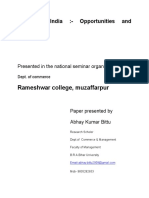Neha Sharma Final Synopsis Capstone
Neha Sharma Final Synopsis Capstone
Uploaded by
inxxxsCopyright:
Available Formats
Neha Sharma Final Synopsis Capstone
Neha Sharma Final Synopsis Capstone
Uploaded by
inxxxsCopyright
Available Formats
Share this document
Did you find this document useful?
Is this content inappropriate?
Copyright:
Available Formats
Neha Sharma Final Synopsis Capstone
Neha Sharma Final Synopsis Capstone
Uploaded by
inxxxsCopyright:
Available Formats
A study on M&A of Indian banking sector strategic and financial implications
A STUDY ON MERGER AND ACQUISITION OF INDIAN BANKING SECTOR-STRATEGIC AND FINANCIAL IMPLICATIONS
Submitted to Lovely Professional University In partial fulfillment of the requirements for the award of degree of MASTER OF BUSINESS ADMINISTRATION
Submitted By Abhishek Verma (3440070066) Maneesh Ranjan (3440070090) Neha Sharma (3440070013) Rahul Verma (3440070004)
Submitted to Ms Neha Tikko lecturer
DEPARTMENT OF MANAGEMENT LOVELY PROFESSIONAL UNIVERSITY PHAGWARA
-1
A study on M&A of Indian banking sector strategic and financial implications
CERTIFICATE
This is to certify that Maneesh Ranjan bearing Registration no. 3440070090 has completed capstone project titled, A STUDY ON MERGER AND ACQUISITION OF INDIAN BANKING SECTORSTRATEGIC AND FINANCIAL IMPLICATIONS under my guidance and supervision. To the best of
my knowledge, the present work is the result of her original investigation and study. No part of the dissertation has ever been submitted for any other degree at any University. The dissertation is fit for submission and the partial fulfillment of the conditions for the award of MBA
Signature and Name of the Research Supervisor
Designation School Lovely Professional University Phagwara, Punjab.
Date :
-2
A study on M&A of Indian banking sector strategic and financial implications
DECLARATION
I, Maneesh Ranjan student of B-tech MBA Biotech under Department of Management of Lovely Professional University, Punjab, hereby declare that all the information furnished in this capstone project report is based on my own intensive research and is genuine. This report does not, to the best of my knowledge, contain part of my work which has been submitted for the award of my degree either of this university or any other university without proper citation.
Date : Signature and Name of the student Registration No.
-3
A study on M&A of Indian banking sector strategic and financial implications
Contents
1) INTRODUCTION TO M&Apg 5 2) THE BRIEF OVERVIEW OF INDIAN BANKING SECTOR.pg 5-6 3) BANKING SECTOR DEVELOPMENT IN INDIA...pg 6 4) REVIEW OF LITERATUREpg 7-10 5) NEED OF STUDY...pg 10 6) OBJECTIVES OF STUDY.pg11 7) LIMITATION OF STUDY..pg11 8) RESEARCH METHODOLOGY..pg 12 9) REFERENCESpg 13-14
-4
A study on M&A of Indian banking sector strategic and financial implications
Introduction to Mergers and Acquisition
Merger is defined as the process in which one company acquires the assets as well as the liabilities of the second company.The first one is survivor here while the the second one is the looser who looses his corporate existence. Generally, the surviving company is the buyer, which retains its identity, and the extinguished company is the seller In India, mergers are called as amalgamations. The acquiring company, also called as the amalgamated company or the merged company acquires the assets and liabilities of the target company . The shareholders of the existing company get the shares of newly amalgamated company.
WHAT IS ACQUISITION?
Acquisition in general sense is acquiring the ownership in the property. In the context of business combinations, an acquisition is the purchase by one company of a controlling interest in the share capital of another existing company. When an acquisition is forced or unwilling act, then it is called take over. A merger involves a marriage of two or more banks. It is generally accepted that mergers promote synergies. The basic idea is that the combined will create more value than the individual banks operating independently. Economist refers to the phenomenon of the 2+2=5 effect brought about by synergy. THE BRIEF OVERVIEW OF INDIAN BANKING SECTOR In India, the Reserve Bank of India is considered to be the central bank of the country. RBI regulates the operations of other banks and helps in managing the money supply of the economy. The Indian banking system consists of two types of banks which are commercial banks and Co-operative banks. Commercial banks play dominant role in the growth of Indian economy and accounts for more than 90 percent of the total assets of the banking sector. Commercial banks are classified into two categories namely Scheduled Commercial Banks and Nonscheduled Commercial Banks.. Based on the pattern of ownership, scheduled commercial banks can also be classified into three broad cateogaries.
-5
A study on M&A of Indian banking sector strategic and financial implications
(1) Public Sector Banks which include (a) State Bank of India and its associates (b) Nationalized Banks (2) Private Sector Banks comprise (a) Indian private banks and (b) Foreign Banks (3) Regional Rural Banks Indian Banking Sectors had started witnessing three major reforms which played a key role in reforming the present situation of the Indian Banking system These reforms were Narishmam Committee I (1991), Narishmam Committee II (1997) and Verma Committee (1999).Environment in which Indian Banking sectors were operated witnessed a remarkable change due to these reforms. The objectives of these reforms were to improve the current conditions of Indian Banking system and to make them enhance there efficiency and promote a diversified and competitive financial sytem.Thus the outcomes of these reforms were to consolidate the Indian banking sectors through merger and acquisition. Technological progress and financial deregulation have played an important role in accelerating the process of merger and acquisition in Indian banking industry.This technological advancement had led to increase productivity and performance as a result the overall profit maximization was there.Size and scale of production was increased to a distinct level.Due to these reasons Indian banks became capable of facing globalization and thus can generate capital from foreign also. Mergers and acquisitions in Indian banking sector have initiated through the recommendations of Narasimham committee. The committee recommended that merger between banks and Development Financial Institutions (DFI's) and Non Banking Financial Corporation's (NBFCs) no to seen as a mean of bailing out weak banks. The committees also stressed, that the combined value of new bank will be greater, than the combined value of merged banks, and have a "forced multiplier effect."
-6
A study on M&A of Indian banking sector strategic and financial implications
BANKING SECTOR DEVELOPMENTS IN INDIA
In todays competitive scenario, if we will see we can find out that Banking sector in India is currently passing through an exciting and challenging phase. The reform measures that were initiated by policy makers have brought about sweeping changes in this vital sector of the country's economy. They studied the trends in important banking indicators for the 25-year period from 1980 to 2005. It is well understood fact that the banking system is central to a nations economy. Banks perform various special functions as they not only accept and deploy large amounts of uncollateralised public funds in a fiduciary capacity, but also leverage such funds through credit creation. In India, prior to nationalisation, banking was restricted mainly to the urban areas and neglected in the rural and semi-urban areas. REVIEW OF LITERATURE The pace of bank mergers and acquisitions is increasing all over the world and it has given rise to an extensive economic research. Today, there is quite an abundance literature available on the subject of bank mergers. In literature, there has been number of studies conducted on the impact of mergers on the efficiency of banks. There is voluminous literature on mergers and acquisitions in developed economies like US but there is dearth of literature in developing economies like India and other Asian countries. The literature suggests that there is mixed empirical evidence regarding the impact of mergers and acquisitions on the efficiency and performance of banks. Pardeep KAUR, Gian KAUR studied the cost efficiency of Indian commercial banks by using a nonparametric Data Envelopment Analysis Technique. They also studied the impact of mergers and there implications on the cost efficiency of those banks that have gone through the process of merger during post liberalization period. The findings of their study also suggest that the cost efficiency of Indian public sector banks were 73.4 % and for private sector banks were 76.3 %. There findings also suggested that to some extent merger programme has been successful in Indian banking sector. It was suggested that the Government and Policy makers should not promote merger between strong and distressed banks as a way to promote the interest of the depositors of distressed banks, as it will have adverse effect upon the asset quality of the stronger banks.
-7
A study on M&A of Indian banking sector strategic and financial implications
Dr. K.A. Goyal & Vijay Joshi They basically explained what were the benefits of merger and acquisition to the Indian banking system. They studied the merger of 17 banks in India. After analysis they found following benefits of merger to all the participants Sick banks were found to get survived after merger. Merger and acquisition had enhanced branch network geographically. Merger and acquisition had led to development of larger customer base (rural reach). Increased market share. Attainment of infrastructure was greatly increased.
Dr Rohan Rai suggested that after the removal of entry barriers and a number of banking-sector reforms have palyed an important role in making the entire banking activity to start hovering around the longawaited customer-centric approach. A large number of new economy private sector banks came into existence because of these reforms in Indian banking system . Although being small in size they had great enthusiasm and zeal to achieve inorganic growth to throw real challenge to monstrous public sector banks. Small is of course beautiful but being big makes one powerful.
Jangaiah Paladi, Akyam Srujan stated that the global M&A scenario is witnessing new highs in terms of value and volume of completed activity. By the end of 2005, world over 24,806 M&A deals worth a combined value of US$2,059 billion were concluded. A significant rise in the number of deals has been recorded in recent times. M&A deals in insurance sector have again gained momentum in 2005, and by September 2005, 191 deals valued at US$ 32,688 million have been recorded. Though the numbers of deals are lower compared to the previous year, the value of the deals is more than double.
Srinivasan R ,Gourav Chattopadhyay, Arvind Sharma suggested that like all business entities , banks want safeguard against risks as well as exploit available opportunities indicated by existing and expected trends. Deregulation has been the main driver, through three major routes - dismantling of interest rate controls, removal of barriers between banks and other financial intermediaries, and lowering of entry barriers. This article looks at some M&As that have happened post-2000 in India to understand the intent
-8
A study on M&A of Indian banking sector strategic and financial implications
(of the targets and the acquirers), resulting synergies (both operational and financial), modalities of the deal, congruence of the process with the vision and goals of the involved banks, and the long term implications of the merger.They explained the benefits and drawbacks of some key M&A deals 2000 onwards. A. Vasudevan suggested that there is little empirical literature on the impact of mergers in banking in India, but what there is supports the view that banks significantly improve their profit and operational efficiencies following consolidation, that has happened both for reasons of financial strength and efficiency. A. Vasudevan surveys the merger scene in the banking sector. K. Ravichandran, Fauzias Mat-Nor, Rasidah Mohd-Said suggested that the banking sector of India is considered as a booming sector and the soundness of the banking system has been vital for the development of the countrys economy. The financial performance suggests that the banks are becoming more focused on their retail activities (intermediation) and the main reasons for their merger is to scale up their operations. A comprehensive study is undertaken to investigate the performance of those banks three years before the merger took place and three years after the completion of the said merger. Also the profitability of the firm is significantly affected giving a negative impact on the returns.They showed that they have adopted CRAMEL (Capital Adequacy, Resources Raising Ability, Asset Quality, Management Quality, Earnings Quality, Liquidity) model to assess efficiency and performance of the Indian banking institutions. Jay Mehta, Ram Kumar Kakani suggested the motives of merger and acquisition of Indian banking sector.India is moving slowly from large number of small banks to small number of large banks.They also compared the International merger and acquisition with Indian scene.They studied the significant role of the state and the central bank in protecting customers interests vis--vis creating players of International size. It is observed that the banking industry is moving from traditional savingscum-lending functions to other services as well such as Bank-assurance and securities trading. They provided the holistic approach to compare the rationale behind M&A in India and the international arena.
-9
A study on M&A of Indian banking sector strategic and financial implications
Dr.Murthy Pamarty Merger and acquisition of Indian banking has occupied an important place amongst the personnel and policy-makers of banking system in recent years, as a sequel to economic reforms to bring in equilibrium sand stability in the banking industry. The financial and strategic management aspect of merger is to be analyzed from several angles and the study evaluated financial implications before and after mergers in the banking industry. Banking is the most important component of the Indian financial system. Merger taking place in India are in line with the trend of consolidation that has characterized the financial services industry and, in particular, the banking industry. Hence the desire to grow quickly through mergers rather than through the slow and tortuous path of normal expansion in business. Their study evaluated financial implications before and after mergers in the banking industry. The first part of their study evaluates the implications of Mergers and Acquisitions from the financial point of view. The second part of their study investigates the adjustments of stock prices to the announcement of mergers/ acquisitions.They explained that there are vairiety of reason to induce merger proposals. Some of them are Synergy, Tax considerations, Economies of scale in operations, Diversification. NEED OF STUDY It is observed in literature that most of the work done on mergers and acquisition is based on financial & accounting aspect like performance of banking institutions based on. The fastest way to mergers, acquisitions, takeover etc, is the combination of firms. Indian government consistently has put forward planned efforts to achieve higher economic growth. Mergers generate gains by improving resource allocation rather than by reducing tax payments of increasing the market power of the combined firm. While Income Tax Act 1961carries some incentives to the merged firms, Indian Companies 1956 provides the procedure for amalgamation. Merger taking place in India are in line with the trend of consolidation that has characterized the financial services industry and, in particular, the banking industry.
- 10
A study on M&A of Indian banking sector strategic and financial implications
SCOPE OF STUDY Efforts have been made to measure the impact of banks merger and acquisition on employees and staffs.A sample of banks who have undergone the process of merger and acquisition in last ten years have been taken.The implications of merger and acquisition on the financial performace of the entities is studied here.The second part of the study is in the adjustment of stock prices to the announcement of merger and acquisition. OBJECTIVES OF STUDY 1. To study the financial impact of Merger and Acquisition of the selected banks between pre and post-merger periods. 2. To study the impact of Merger and Acquisition of the selected banks on the operating performance of Banking Index between pre and post-merger period. 3. To study the factors influencing M&A of banks in Indian banking scenario
LIMITATION OF STUDY 1. The study is totally based on banking sector and no comparison with other sectors is made here. 2. To generate the information about the profitability and liquidity position during M&A. 3. The study is limited to five years before merger and five years after merger only. 4. Accounting ratios have its own limitation which is also applied to the study.
- 11
A study on M&A of Indian banking sector strategic and financial implications
RESERCH METHODOLOGY: Research methodology is basically for analyzing the primary and secondary data using research instruments. Research methodology is a way to systematically solve the problem. It may be understood has a science of studying how research is done scientifically. In it we study the various steps that all generally adopted by a researcher in studying his research problem along with the logic behind them. The scope of research methodology is wider than that of research method.
Research Design: Sample Size: Balance Sheet and Income Statements of pre and post merger annual financial statement
of five stated banks from 2000 onwards. 1. HDFC bank acquires Centurian bank of Punjab ( may08) 2. Oriental Bank of Commerce Acquires Global Trust Bank Ltd (August '04) 3. ICICI Bank Acquires Bank of Rajasthan ( May'10)
4. Bank of Baroda Acquires South Gujarat Local Area Bank Ltd (June '04) 5. ICICI Bank Ltd. Acquires Bank of Madura (March '01)
Sample Unit: Private and Public sector banks. Research Data Collection: Secondary Data Collection. Research Hypothesis:
Null Hypothesis: There is no significant financial impact of merger on public and private sector. Alternative Hypothesis: There is significant financial Impact of merger on public and private sector. Research Instruments: Spss used for analyzing and empirical testing of hypothesis/
REFERENCES
- 12
A study on M&A of Indian banking sector strategic and financial implications
Research Articles and Journals
Dario Focarelli, Fabio Panetta and Carmelo Salleo, (Nov., 2002), Why Do Banks Merge?, Journal of Money, Credit and Banking, Vol. 34, No. 4, pp. 1047-1066 http://www.jstor.org/pss/3270727 Kaur, Gian, Pardeep, 2010 , Bank mergers cost efficiency gains among commercial banks in India. Indian Journal of Economics and Business , Volume: 9, Source Issue: 1 http://www.freepatentsonline.com/article/Indian-Journal-EconomicsBusiness/225073259.html
Bhaskar A Uday,Ratnam C.S,Bhal,2006, Role of communication and hr integration: a study of a bank merger http://www.ilera-online.org/15thworldcongress/files/papers/Track_1/Poster/CS1W_13_BHASKAR.pdf Goyal, Joshi Vijay,2003, Mergers in banking industry of india: some emerging issues, Asian Journal Of Business And Management Sciences, Vol. 1 No. 2 [157-165] http://www.ajbms.org/articlepdf/ajbms_2011_1231.pdf Kaur Pardeep,Kaur Gian, 2010, Impact of Mergers on the Cost Efficiency of Indian Commercial Banks, Eurasian Journal of Business and Economics,vol3 (5),pp 27-50 http://ejbe.org/EJBE2010Vol03No05p27KAUR-KAUR.pdf Rai rohan,2011, corporate excellence through mergers and acquisitions: a Study of icici bank bank of madura merger, asian journal of technology & management research,, vol. 01 issue: 01 http://ajtmr.com/papers/vol1issue1/CORPORATE-EXCELLENCE-THROUGH-MERGERS-ANDACQUISITIONS.pdf
Paladi, Srujan,2005, mergers and acquisitions in insurance industry - 13
A study on M&A of Indian banking sector strategic and financial implications
http://www.actuariesindia.org/GCA/9thGCA/MERGERS%20AND%20ACQUISITIONS%20IN %20INSURANCE%20INDUSTRY.pdf Ravichandran K., Said Rasidah, 2010, Market Based Mergers in Indian Banking Institutions, International Research Journal of Finance and Economics, Issue 37 http://www.eurojournals.com/irjfe_37_03.pdf Srinivasan R. ChattopadhyayGourav, Sharma Arvind,2011,M & A in Indian banking sector Strategic and Financial implications,An IIMB management review http://tejas-iimb.org/articles/01.php Vasudevan A.,2004, Bank M&A: Stability and synergy, Financial Daily from THE HINDU group of publications http://www.thehindubusinessline.in/2004/11/11/stories/2004111100071000.htm
- 14
You might also like
- Strategic Management Spring 2015 First Asignment Mintzberg and WaltersDocument7 pagesStrategic Management Spring 2015 First Asignment Mintzberg and WaltersIlko KacarskiNo ratings yet
- CORRECTIONS and Amendments From Barry BSS056-6 July 12AAADocument15 pagesCORRECTIONS and Amendments From Barry BSS056-6 July 12AAAjay alsopNo ratings yet
- Assignment - 1 - Attempt ReviewDocument17 pagesAssignment - 1 - Attempt ReviewAmit PandeyNo ratings yet
- Sports Tourism Evolution and Development As of Jan 26 2010Document8 pagesSports Tourism Evolution and Development As of Jan 26 2010Toby MijaresNo ratings yet
- Opme003 MergedDocument78 pagesOpme003 Mergedvishalmalik3No ratings yet
- Quiz 4Document27 pagesQuiz 4Jayson TasarraNo ratings yet
- 202c - Business EnvironmentDocument22 pages202c - Business EnvironmentHemanth Kumar100% (1)
- Be Industrilization 2Document20 pagesBe Industrilization 2JAY SolankiNo ratings yet
- EGMC004 Exam PDFDocument22 pagesEGMC004 Exam PDFhimanshubansal750No ratings yet
- D) All of These (Answer All)Document9 pagesD) All of These (Answer All)Kavita VermaNo ratings yet
- Seven Basic Principles of Software Engineering by Barry W. BoehmDocument22 pagesSeven Basic Principles of Software Engineering by Barry W. BoehmAbdul KhanNo ratings yet
- Fin C 000002Document14 pagesFin C 000002Nageshwar SinghNo ratings yet
- Synopsis PDFDocument3 pagesSynopsis PDFaparajita raiNo ratings yet
- HRMC002 - 10: Sumit Singh Full DescriptionDocument213 pagesHRMC002 - 10: Sumit Singh Full Descriptionsunidheeojha2001No ratings yet
- Semester 2 Online Class ScheduleDocument1 pageSemester 2 Online Class Scheduleishans singhNo ratings yet
- Marketing Management-1 08.03.2022 MBSDocument18 pagesMarketing Management-1 08.03.2022 MBSMani Bhushan SinghNo ratings yet
- OMPC002 Final Edition YnRDocument18 pagesOMPC002 Final Edition YnRSri Mega Security100% (1)
- Opme004 Assignment QuestionsDocument4 pagesOpme004 Assignment Questionsvishalmalik3No ratings yet
- HRMC002Document8 pagesHRMC002Nageshwar SinghNo ratings yet
- Assistant Director - FinanceDocument8 pagesAssistant Director - FinanceVon Eric DamirezNo ratings yet
- Production Operations Management - MGT613 Quiz 4Document31 pagesProduction Operations Management - MGT613 Quiz 4Rahul JawdaNo ratings yet
- 01 PRMGT - 052020 - Online Exam - QuestionDocument2 pages01 PRMGT - 052020 - Online Exam - QuestiondropjarNo ratings yet
- Benchmarking of HONDA AND BAJAJDocument11 pagesBenchmarking of HONDA AND BAJAJvibhavNo ratings yet
- Mba 3 Sem Data Mining For Business Decisions 76987 Jan 2021Document2 pagesMba 3 Sem Data Mining For Business Decisions 76987 Jan 2021PALLAVI GHODICHORENo ratings yet
- Unit 3Document47 pagesUnit 3Usha Nandhini100% (4)
- Principle of Economics-2 08.03.2022 MBSDocument16 pagesPrinciple of Economics-2 08.03.2022 MBSMani Bhushan SinghNo ratings yet
- MM ZG627 Ec-2r First Sem 2017-2018Document1 pageMM ZG627 Ec-2r First Sem 2017-2018UDAYAN BIPINKUMAR SHAHNo ratings yet
- Production & Operations Management (OM)Document101 pagesProduction & Operations Management (OM)mayan_treasure9625No ratings yet
- Management Information Systems Lecture NotesDocument65 pagesManagement Information Systems Lecture NotesazinwiborisNo ratings yet
- 307 International Business-EnvironmentDocument31 pages307 International Business-EnvironmentDineshNo ratings yet
- RM MCQDocument2 pagesRM MCQAstha GandhiNo ratings yet
- Project ManagementDocument26 pagesProject ManagementSanjay Kumar JhaNo ratings yet
- Organizational Study at ITI LTD, PalakkadDocument12 pagesOrganizational Study at ITI LTD, PalakkadVishnu S KumarNo ratings yet
- Marketing 1Document11 pagesMarketing 1Ojaswini AroraNo ratings yet
- 105 ObDocument19 pages105 ObAmol KareNo ratings yet
- Question Set Manufacturing System Analysis & ManagementDocument10 pagesQuestion Set Manufacturing System Analysis & Managementnidhi.cse23100% (1)
- Project Report On: "New Product Development Process in Textile Industry"Document54 pagesProject Report On: "New Product Development Process in Textile Industry"lalit kumarNo ratings yet
- HRMC002 Organization Behaviour Assignment V2 27.8.22 PDFDocument16 pagesHRMC002 Organization Behaviour Assignment V2 27.8.22 PDFNageshwar SinghNo ratings yet
- Proposal For Management FestDocument5 pagesProposal For Management FestAshutosh SinghNo ratings yet
- EGMC Assgn PDFDocument9 pagesEGMC Assgn PDFNageshwar SinghNo ratings yet
- Internship Project Completion Certificate To Whomsoever It May ConcernDocument1 pageInternship Project Completion Certificate To Whomsoever It May ConcernYusuf MalikNo ratings yet
- Business Familiarization Report KgsDocument56 pagesBusiness Familiarization Report KgsChandan GoraiNo ratings yet
- Critical ThinkingDocument7 pagesCritical Thinkingrudrakshvijayvargiya4000No ratings yet
- Ester Industries LTD.: Internship Training ReportDocument18 pagesEster Industries LTD.: Internship Training Reportkarpal singhNo ratings yet
- Startegic Management Consolidated Assignment-1 - 10th February 22Document37 pagesStartegic Management Consolidated Assignment-1 - 10th February 22Mani Bhushan SinghNo ratings yet
- VALUATION OF SHARES PPT Anshuman PradhanDocument12 pagesVALUATION OF SHARES PPT Anshuman PradhanAnshuman PradhanNo ratings yet
- Principle of Economics-1 08.03.2022 MBSDocument16 pagesPrinciple of Economics-1 08.03.2022 MBSMani Bhushan SinghNo ratings yet
- CCE 1 211 GE UL - Business Government & SocietyDocument1 pageCCE 1 211 GE UL - Business Government & Societyadityajagdale3No ratings yet
- Swot and Etop AnalysisDocument12 pagesSwot and Etop AnalysisSanjeev SanjuNo ratings yet
- Display Advertising PowerPoint PresentationDocument17 pagesDisplay Advertising PowerPoint PresentationJyoti JNo ratings yet
- Financial Markets and Institutions Solved MCQs (Set-10)Document6 pagesFinancial Markets and Institutions Solved MCQs (Set-10)Tonie NascentNo ratings yet
- Principle of Economics Consolidated Assignements-2 - 10th February 22Document27 pagesPrinciple of Economics Consolidated Assignements-2 - 10th February 22Mani Bhushan SinghNo ratings yet
- EtopDocument7 pagesEtopAnilBahugunaNo ratings yet
- Completed Project Report IMT Analysis of Performance Measurement in Warehouse - A Case of NNR Global Logistics 3rd March 2022Document76 pagesCompleted Project Report IMT Analysis of Performance Measurement in Warehouse - A Case of NNR Global Logistics 3rd March 2022SuNil AdhiKariNo ratings yet
- MKT-501 Consumer Behavior Course Specification Fall-2019-20Document11 pagesMKT-501 Consumer Behavior Course Specification Fall-2019-20Usama Ch100% (1)
- BSCM Quiz Session 1 PDFDocument3 pagesBSCM Quiz Session 1 PDFmenagesNo ratings yet
- Quality Assurance in Banking ServicesDocument2 pagesQuality Assurance in Banking ServicesmuhammadsaliNo ratings yet
- Managerial EconomicsDocument14 pagesManagerial Economicsmssharma500475% (4)
- MisDocument41 pagesMisinnocentevilshahidNo ratings yet
- Crossing of ChequesDocument48 pagesCrossing of ChequesinxxxsNo ratings yet
- Capstone ProjectDocument10 pagesCapstone ProjectinxxxsNo ratings yet
- Eco Term Paper FinalDocument27 pagesEco Term Paper FinalinxxxsNo ratings yet
- Sustainable ConsumptionDocument2 pagesSustainable ConsumptioninxxxsNo ratings yet
- Finance Project On Working Capital Management BANK of BARODADocument67 pagesFinance Project On Working Capital Management BANK of BARODASANJEEV KUMAR100% (1)
- Finals StratCostDocument7 pagesFinals StratCostMarie AzaresNo ratings yet
- Emancipate Yourselves Form Mental SlaveryDocument45 pagesEmancipate Yourselves Form Mental SlaveryTristram HooleyNo ratings yet
- Overview of Franchise Industry in IndiaDocument4 pagesOverview of Franchise Industry in IndiamohanprasanthNo ratings yet
- Project Report On Kajaria Ceramic LTD For BBADocument52 pagesProject Report On Kajaria Ceramic LTD For BBAPari Savla100% (2)
- Sea NR77 - 5 - NR81 - 5Document43 pagesSea NR77 - 5 - NR81 - 5ozgurbozkurt111No ratings yet
- Your Business Model StrategyDocument12 pagesYour Business Model StrategycourtbergenNo ratings yet
- 6 - Importance of Knowing The Right Tariff Code of Your ProductDocument19 pages6 - Importance of Knowing The Right Tariff Code of Your ProductRyanna Ang-angcoNo ratings yet
- Interactive Energy DashboardsDocument8 pagesInteractive Energy Dashboardsapi-16652449No ratings yet
- 1st Quarter Test - THERESADocument20 pages1st Quarter Test - THERESATheresa Fe L. NicartNo ratings yet
- CS Form No. 212 Attachment Work Experience SheetDocument1 pageCS Form No. 212 Attachment Work Experience Sheetraikha barraNo ratings yet
- JFK Airtrain Brochure EnglishDocument2 pagesJFK Airtrain Brochure Englishপিঁপড়া পিঁপড়াNo ratings yet
- Quiz 1 - Microeconomics Pindyck and Rubinfeld MCQ QuestionsDocument3 pagesQuiz 1 - Microeconomics Pindyck and Rubinfeld MCQ Questionsanusha500100% (3)
- Economic Analysis: Ashok Kumar RawaniDocument14 pagesEconomic Analysis: Ashok Kumar RawaniAman RajNo ratings yet
- Startup India Standup IndiaDocument6 pagesStartup India Standup IndiaabhaybittuNo ratings yet
- CPLSTDocument2 pagesCPLSTNam NguyenNo ratings yet
- Schedule of Renewal For BIR-Importers Clearance Certificate For April 2017Document11 pagesSchedule of Renewal For BIR-Importers Clearance Certificate For April 2017PortCallsNo ratings yet
- 09 Chapter2 PDFDocument54 pages09 Chapter2 PDFUnaiz MuhammedNo ratings yet
- EC823 S2013 nn10 SlidesDocument61 pagesEC823 S2013 nn10 SlidesFroso ErotokritouNo ratings yet
- Finance Project On ACC CEMENTDocument87 pagesFinance Project On ACC CEMENTShilpan Shah80% (5)
- 3D-Vjezba IIIDocument4 pages3D-Vjezba IIIhajrudinNo ratings yet
- DYPATIL PDF Heritage India PDFDocument159 pagesDYPATIL PDF Heritage India PDFSonali ManeNo ratings yet
- Short Notice AP Grama Volunteer Posts PDFDocument3 pagesShort Notice AP Grama Volunteer Posts PDFKalyan GadirajuNo ratings yet
- Reconsideration of The World Design Conference 1960 in Tokyo and Theworld Industrial Design Conference 1973 in KyotoDocument10 pagesReconsideration of The World Design Conference 1960 in Tokyo and Theworld Industrial Design Conference 1973 in KyotokenkothecatNo ratings yet
- Gems of Poetry, For Girls and Boys by UnknownDocument36 pagesGems of Poetry, For Girls and Boys by UnknownGutenberg.orgNo ratings yet
- Capstone Education: Maths For Demo ClassDocument2 pagesCapstone Education: Maths For Demo Classriad rijviNo ratings yet
- Tutorial 5 - Putting The Enterprise Into The Enterprise System - Docx-DikonversiDocument3 pagesTutorial 5 - Putting The Enterprise Into The Enterprise System - Docx-DikonversikarimanrlfNo ratings yet
- Common Tea Pest and Pesticide Use in NepalDocument13 pagesCommon Tea Pest and Pesticide Use in Nepalkhadka80% (5)
- QSAF004II2024 Ramp Safety AwarenessDocument2 pagesQSAF004II2024 Ramp Safety AwarenessMasagus Taufik HalimNo ratings yet


























